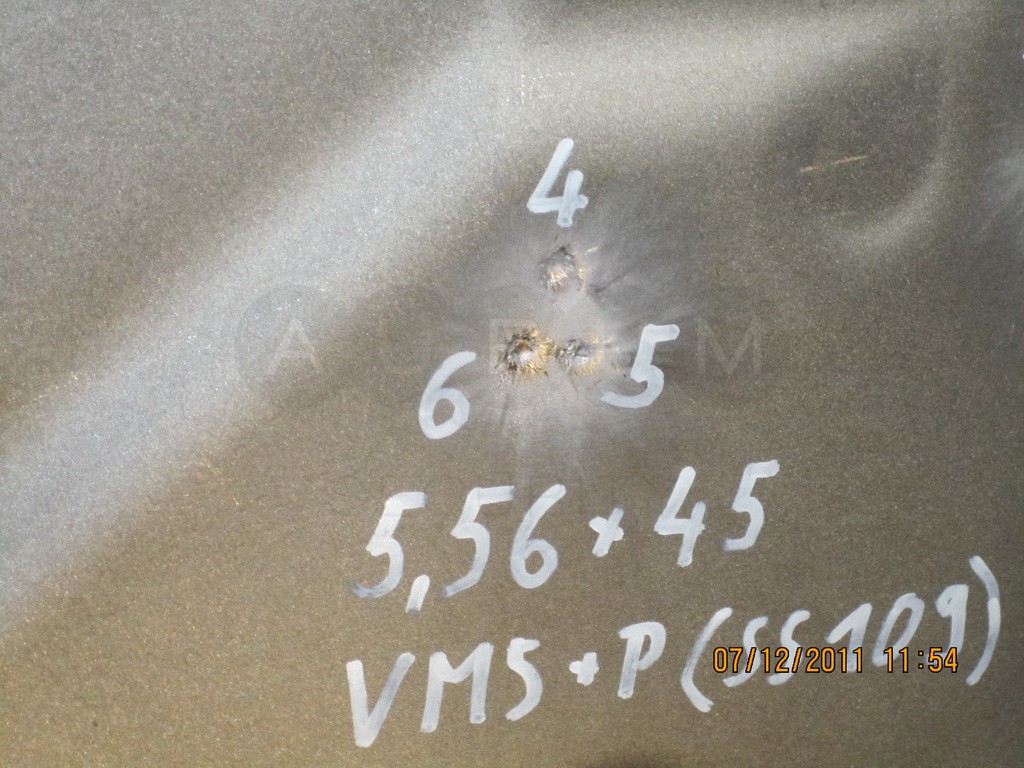
Brief introduction to ballistics
Ballistics is the science that studies material behavior under stress generated by the impact of projectiles, such us bullets or shrapnel, at high speeds. This provides a basis for systematization and development of certified protection materials for armored vehicles and involves extensive testing and research.
A security glazing standard known as EN 1063 or CEN 1063 created by the European Committee for Standardization for measuring the protective strength of bullet-resistant glass. This protective strength of a glazed shielding is rated based on the type of munitions or threat level, it is capable of withstanding. Thus there are seven main standard threat levels – BR1-BR7 also written as B1-B7, each corresponding to a different type of small arms fire. In addition, there are two other threat levels (SG1 and SG2) сcorresponding to shotgun munitions. However, the SG (shotgun) classes do not necessarily comply with BR classes.

Abbreviation "FB" is defined in the standard DIN EN 1522 and is used to indicate the protection level of opaque (non-transparent) materials, such as armor steel, kevlar, twaron, aramid, UHMwPE (Ultra High Molecular weight Polyethylene like Dyneema or Spectra), ceramic etc.
An European body VPAM – Vereinigung der Prüfstellen für angriffshemmende Materialien und Konstruktionen (Association of Centers for Certification of Bullet-resistant Materials and Constructions) – defines 14 protection levels instead of 7 levels as were defined by the standards EN 1522 / EN 1063.
 In 1999, Association of test laboratories for bullet resistant materials and constructions (VPAM) was founded by a number of certification centers in order to promote exchange of experience and work out common guidelines testing bullet resistant materials and constructions.Test Houses at Mellrichstadt, Munich, Ulm, Vienna, and other European institutions are accredited under the VPAM.Advantages of the VPAM are additional classes, sorted by the kinetic energy of the bullet, but there are disadvantages, in particular, VPAM does not specify yaw angle. Yaw angle – obliquity angle when the bullet touches the material.After introduction of VPAM, a lot of confusion has aroused. The point of this confusion was that the most popular protection class for civil vehicles - B6 – was marked as VPAM 7 and B7 was marked as VPAM 9. A correspondence of these classifications is shown here.In 2006 VPAM introduced a new standard - APR 2006, which defined 14 protection levels and was meant as a basis for ballistic testing of materials, construction and objects:
In 1999, Association of test laboratories for bullet resistant materials and constructions (VPAM) was founded by a number of certification centers in order to promote exchange of experience and work out common guidelines testing bullet resistant materials and constructions.Test Houses at Mellrichstadt, Munich, Ulm, Vienna, and other European institutions are accredited under the VPAM.Advantages of the VPAM are additional classes, sorted by the kinetic energy of the bullet, but there are disadvantages, in particular, VPAM does not specify yaw angle. Yaw angle – obliquity angle when the bullet touches the material.After introduction of VPAM, a lot of confusion has aroused. The point of this confusion was that the most popular protection class for civil vehicles - B6 – was marked as VPAM 7 and B7 was marked as VPAM 9. A correspondence of these classifications is shown here.In 2006 VPAM introduced a new standard - APR 2006, which defined 14 protection levels and was meant as a basis for ballistic testing of materials, construction and objects:Test level Type of weapon Weapon Calibre Ammunition and projectile Test conditions Type Mass [g] Manufacturer type Shot distance [m] Bullet velocity [m/s] 1 K/L 
22 Long Rifle L/RN 2.6 ± 0.1 Winchester 10 + 0.5 360 ± 10 2 K 
9 mm Luger FMJ/RN/SC, tinned 8.0 ± 0.1 DAG, DM 41 5 + 0.5 360 ± 10 3 K 
9 mm Luger FMJ/RN/SC, tinned 8.0 ± 0.1 DAG, DM 41 5 + 0.5 415 ± 10 4 K 
357 Magnum FMJ/CB/SC 10.2 ± 0.1 Geco 5 + 0.5 430 ± 10 44 Rem. Mag. FMJ /FN/SC 15.6 ± 0.1 Speer 5 + 0.5 440 ± 10 5 K 
357 Magnum FMs/CB 7,1 ± 0.1 DAG special 5 + 0.5 580 ± 10 6 L 
7.62 x 39 FMJ/PB/FeC 8,0 ± 0,1 core 3.6 PS cold hardened 10 + 0.5 720 ± 10 7 L 
223 ReM. FMJ/PB/SCP 4.0 ± 0,1 MEN. SS 109 10 + 0.5 950 ± 10 308 Win. FMJ/PB/SC 9,55 ± 0,1 MEN. DM 111 10 + 0.5 830 ± 10 8 L 
7.62 x 39 FMJ/PB/HCI 7.7± 0,1 Core 4,1 Hardness 65 HRC BZ 10 + 0.5 740 ± 10 9 L 
308 Win. FMJ/PB/HC 9.70 ± 0,2 Core 4,0 ± 0.1 Hardness 65 ± 2 HRC MEN/CBC, FNB, P 80 10 + 0.5 820 ± 10 10 L 
7,62 x 54 R FMJ/PB/HCI 10.4 ± 0,1 Core 5,3 Hardness 63 HRC B32 10 + 0.5 860 ± 10 11 L 
308 Win. FMJ/PB/WC 8.4 ± 0,1 Core 5,9 Nammo, AP 8 10 + 0.5 930 ± 10 12 L 
308 Win. FMJ/PB/WC 12.7 ± 0,1 Core 5,58 Hardness 1330 HV 10 SWISS P AP 10 + 0.5 810 ± 10 13 L 
50 Browning FMJ/PB/HC 43,0 ± 0,5 Core 35.0 Hardness 55±2 HRC SWISS P penetrator 100 930 ± 20 14 L 
14.5 x 114 FMJ/PB/HCI 63.4 ± 0.5 832 100 911 ± 20 The rates of twist can be gathered from the dimension sheets (TDCC) of the C.I.P. Currently the following organizations constitute VPAM:Beschussamt Wien (A)Rüstungsdirektion, Amt für Rüstung und Wehrtechnik, Felixdorf (A)Royal Military Academy, Dept. of Weapon Systems & Ballistics (ABAL), Brüssel (B)Universität Bern, Institut für Rechtsmedizin, Bern (CH)Wissenschaft & Technologie, Thun (CH)Beschussamt Mellrichstadt (D)Beschussamt München (D)Beschussamt Ulm (D)Deutsche Hochschule der Polizei, Polizeitechnisches Institut, Münster (D)vts Politie Nederland, Apeldoorn (NL)TNO Defence, Security and Safety, Rijswijk (NL)Politiets data - og materielltjeneste, Oslo (N)
Standard issued by NATO standardization agreement covering the standards for the “Protection Levels for Occupants of Logistic and Light Armored Vehicles” was suggested to consolidate different threats for meaningful comparison. STANAG4569 covers the standards not only of strikes from Kinetic Energy and artillery but also IED blasts.
STANAG 4569 distinguishes five levels of protection:
Level 1: requires NATO Ball (Ball M80) with size 7.62 х 51 in the distance of 30 meters with velocity 833 m/s. This level includes unexploded artillery fragmenting submunitions, hand grenades, and other not big anti personnel explosive devices detonated under vehicle.
Level 2: encompasses size of object 7.62 x 39 API BZ in the distance of 30 meters with velocity 695 m/s. Grenade and Mine Blast Threat of this level is considerate to be 6 kg of explosive mass and subdivided into sublevels such as
- 2a which relates to mine explosion pressure activated under any wheel or track location
- 2b – implicated when mine explosion occurs under center.
Level 3: intends on size of 7.62 х 51 AP (WC core) in the distance of 30 meters with velocity 930 m/s. Grenade and Mine Blast Threat of this level includes 8 kg of explosive mass and divided into two sublevels:
- 3a – pressure of mine explosions activated under any wheel or track location
- 3b – mine explosion under center.
Level 4: size is 14.5х114АР/B32 at 200 meters with 911 m/s. Artillery of this level is considered to be 155 mm of High Explosive in the distance of 30 m. Concerning the Grenade and Mine Blast Threat, this level requires 10 kg of explosive mass and also is divided into two sublevels:
- 4а- pressure of mine explosion activated under any wheel or track location
- 4b – explosion of mine under center.
Level 5: requires 25 mm APDS-T(M791) or TLB 073 in the distance of 500 meters with 1258 m/s and Artillery of this level must be 155 mm of High Explosive in the distance of 25 m.

Issued by Underwriters Laboratory (the nation’s leading third-party product safety certification agency). Few companies actually have their materials tested by the Underwriters Laboratory. Instead they turn to a dedicated materials lab that scrupulously follows the UL standard. In the case of UL 752, the material to be tested is securely mounted 15 feet from the muzzle of the test firearm (which is itself locked into a bench rest).
A clean piece of 1/8 th-inch-thick corrugated cardboard (called a “witness plate”) is mounted 18 inches behind the test piece. The witness plate is checked after each shot in order to indisputably establish not just whether or not the bullet beat the barrier (which tends to be pretty obvious), but also whether there was any spalling.
The eight levels of UL-rated bullet resistance are broken into three groups, each with its own protocol:
Level 1: through 3 bullet resistant glasses
For Level 1 through Level 3 bullet resistant glass (meant to protect against 9 mm, .357 Magnum, and 44 Magnum rounds), a fresh sample must stop:o Three shots within a 4-inch triangle with no spalling on the “protected” side
o Three shots within a 1.25 to 1.75-inch area (some spalling is acceptable)
o One unsupported edge shot (some spalling is acceptable here, too)
Level 4 and 5 bullet resistant glass
Level 4 or 5 bullet resistant glasses are meant to stop a single shot from a .30-06 or AK-47 assault rifle, respectively. Samples must stop:
o One center shot
o One unsupported edge shot (some spalling is OK)
Level 6 through 8 bullet resistant glasses
These levels of security are intended to stop bursts from submachine guns and assault rifles, such as UZIs, M16s, and AK-47s. Level 6 through 8 bullet resistant glass must stop:
o Five shots within a 4.5 inch squareYou might assume that a bullet resistant system made from UL-rated materials is as bullet resistant as its component pieces.
You might assume that a bullet resistant system made from UL-rated materials is as bullet resistant as its component pieces. Nonetheless any assembly sold as having a given “UL-rating” must be independently tested under laboratory conditions and meets the UL specification.

